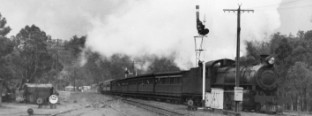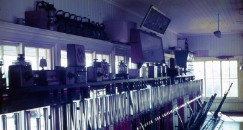Albany Loco Cabin
Quick Facts |
|
Opened |
Closed |
1897 |
1961 |
Mechanical |
Electrical |
? Levers |
? |
Fate: Unknown |
|
Throughout the second half of the 19th century Albany had, thanks to its magnificent natural harbour, the distinction of being the most important port for the colony of Western Australia. Its importance was such that it was connected to the Western Australian Government Railways network (at Beverley) in 1889, a mere 8 years after the opening of the Perth to Guildford railway, which, at first blush appears to have been a considerable achievement for a colony that had fewer than 50,000 settlers. Such an enterprise was perhaps not quite as monumental as it might first appear, for the line was effectively built at no cost to the WA taxpayer, being constructed on the “land grant’ principle. This principle was simplicity itself: the government gave a company large grants of crown land in return for the construction of a railway line. A company, known as the WA Land Company, was floated in the United Kingdom to build and operate the railway from Beverley to Albany, the potential shareholders lured by the prospect that the railway would open up large areas of cultivatable land to provide the traffic for the railway to haul and generate healthy profits. To that end, in 1886 the WA Land Company began construction of a railway from Beverley to Albany, which was to become known as the Great Southern Railway (or “GSR”) a title by which the line is still known today. For convenience, the reference to the GSR in this article will mean the WA land Company trading as the Great Southern Railway.
The GSR was opened in March 1889. Its headquarters was in Albany, where its principal locomotive depot was located. The company’s other depot was at Katanning, the station closest to the midpoint of the line. Albany loco was located at the base of York Street, a few chains west of the station. The company’s workshops were located a mile or so west of Albany. The GSR did not turn out to be the success for which its backers had hoped, and for most of its existence ran at a loss or only made a small profit.
In late 1896 it was bought by the WA Government for the amount of one million one hundred thousand pounds, for which it received a railway worth three hundred thousand pounds and land (which it had given away free) worth eight hundred thousand pounds. No doubt this deal was to be the inspiration for a generation of criminals, sorry toll road owners, a century later. The government probably did not mind too much, as the treasury coffers were full of gold rush taxes and the sale earned the undying love of the good residents of Albany who considered the GSR to be a predatory bete noir.
Following the takeover of the GSR by the WA government in December 1896, the WAGR undertook a suite of improvements to the railways infrastructure, which included the construction of a new loco depot on the site of the old GSR workshops and the introduction of electric staff working between the new depot and the station, the latter occurring in September 1897. The old GSR loco shed became the carriage shed.
The first fixed signal known to have been installed at Albany (see the entry for Albany cabin) was placed at the Albany Loco depot - or to be correct the then new Albany loco depot, probably to provide that location with a modicum of protection as the approach to the depot from Albany was through several deep cuttings. The signal, a Down Distant, (applicable for trains leaving Albany, as this was prior to July 1899, when 'Up and Down directions were reversed) was installed some time prior to June 1898. Weekly Notice No. 19 of 1898 reported that this signal had been removed, In all likelihood this down distant had been introduced as a temporary expedient at the time the locomotive depot was opened (the lack of any reference to a home would tend to support this supposition) although the possibility that it may have been a Great Southern Railway signal cannot be dismissed out of hand.
The same weekly notice advised that Albany Loco was now protected by Up and Down Home and Distant signals. The signals which were brought into operation on the 9th June 1898, were worked by levers located at the staff cabin which was adjacent to the down facing points. The height of the signal posts were 20’ high, the fourth (the Down Home) being 30’ high. This no doubt was due to the need to provide appropriate sighting distances from Albany. The Up Home was located 11 yards from the facing points, the up distant 630 yards from the points, the Down Distant 398 yards and the Down Home 42 yards. From the above one can reasonably infer that there was no crossing loop at the loco, and that this Safeworking location existed purely to enable locomotives to travel to and from Albany and the depot. Presumably the local instructions provided that passenger and goods trains could not cross each other at Albany Loco, as this would have seen the Albanian equivalent of a Mexican stand-off with the down train having to retreat back to Albany.
For how long the signals remained at the new depot is a moot point: the Weekly Notices are silent as to their removal. They had certainly been removed by 1912, as the General Appendix published that year makes no mention of signals at Albany Loco This was not an oversight as Albany Loco had had been reduced to the status of an intermediate siding. On a railway operated by the rules applicable to Train Electric Staff working an intermediate siding was one within a section, and as only one train could be in a section at any one time, signals at such a siding could have served no purpose.
Albany Loco was to remain an intermediate siding until 1951, the low levels of traffic on the GSR for the first decades of the 20th century seeing little operational need for a return to its 1898 era glory. Operationally this did provide a few problems. Locomotives travelling between Albany Loco and Albany station had to be in possession of the Staff for the Albany - Elleker section, which had to be transferred to or from Albany Loco to Albany station (probably by foot or bicycle) as the case required. No doubt to the accountants at WAGR head office the cost of a bicycle or shoe leather was less than the expense of installing new staff instruments. However, the opening up of much of the area around Mount Barker after World War two and a general improvement in the price of wool saw a steady increase in traffic to the port. New factories (including a superphosphate works and a fish canning factory) were opened to the West of the town increasing the amount of traffic running between loco and the station, and to facilitate this Albany Loco was opened as an Auxiliary Staff station in 1951. It was not to be graced with its own fixed signals as such facilities were pointless. An Auxiliary Staff station allowed a train to enter or terminate at a location within a staff section, but did not allow two trains to be in the same section at the one time.
The opening of Albany Cabin in 1960 saw the closure of the Albany - Albany Loco depot Auxiliary Staff Section. The loco depot was incorporated within Albany station limits with a there aspect colour-light searchlight signal protecting the entrance to Loco. In 1973 Albany Loco was relocated to Albany station yard (only a few chains away from the site of the original GSR depot), accessed from the yard by a humble set of ground throw points, ironically the same sort of arrangements that applied in GSR days. Albany Loco was never to rise to the days of its Safeworking glory, Albany losing its interlocking in the 1990s and its loco facilities a decade later. Ironically, the line from Beverley to Albany is again privately operated. In that sense the wheel has turned full circle, from private to public to private ownership, although only a fool would assume that the wheel has stopped there and will not turn again.
Any additional information on this signal cabin would be most welcome - please use the e-mail form provided on this page.
Information researched and interpreted by SIGWA member Justin Smith
This page is copyright, and permission must be sought from SignallingWA before this page is used for any purpose other than personal education.
[Buy this page] or [View your SignallingWA ShoppingCart]
ALBANY LOCO Employees | ||
This list may not be complete and does not yet include employees who worked here without being appointed. Where an appointment date is unknown, the Weekly Notice (WN) date advising of the appointment or other official documentation, i.e. Certificate of Competency (CC) will be used. | ||
Name | Appointed | Position |
Is a name missing? Please submit any corrections / additions with suitable evidence using the e-mail form above. | ||


